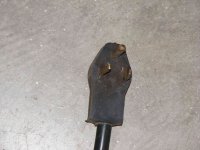Iceman65 said:
Hmmm, interesting reading here.

Yes indeed, verrrrrrry interesting but...
Lets see if I can put out the flames with a dash of gasoline and some breeze.
Let me assure everyone I am not a licensed electrician or an electrical inspector but have gained a little experience being around electrons for a few decades (have made living as electronic engineer for a while.) My take on this thread is pretty close to Gemini's.
While it is theoretically possible (I have done it) to use two separate 120 vac circuits to produce 240vac it is NOT recommended.
Q: What is a 240 VAC breaker?
A: Two 120 VAC breakers mechanically ganged to "KILL" both legs if either one meets the "trip" specs.
The idea stated about 120VAC running through the welder's transformer to neutral and then the other leg of 120 running through the transformer to neutral is one way to design a welder BUT it is not the way any of the welders I have ever seen are designed. Common welders like a Lincoln tombstone has 240 VAC applied across the primary which is NOT center tapped for a neutral connection.
There are two areas of concern in sizing the wire for a welder. 1. the wires from the breaker to the outlet and 2. the wire from the plug to the welder. Wire #1 is to be sized to meet code and prevent a fire in the wall or wherever and as Gemini pointed out should never be undersized compared to the breaker, NO MATTER WHAT!!!
The wire (called #2 above) from the plug to the welder, supplied by the maker (often with plug) may and often is of lesser size than the wire needed in the wall.
Q: Why is that?
A: the wire is short and exposed to cooling air and is big enough for such a short run and saves the mfg a buck.
Long wires drop more voltage at any given size (waste power/make heat) short wire may drop more volts per unit of distance but thankfully are short so do not ordinarily cause a problem in the case of the power cord of UL approved equipment. The manufacturer has covered his backside liability wise and his choice of wire size for the short power cord supplied is OK. (well, OK enough)
Do not even begin to think if it is good enough for the manufacturer it is good enough for you and run the same size in the wall. BAD IDEA!! (see above)
I didn't note for sure if the original poster was wiring in the basement and welding elsewhere or welding in the basement. If welding in the basement the ventilation is most likely woefully inadequate and as others pointed out, a respirator will help the weldor but not anyone sharing the house. IF there is a basement window AND it were fitted with a powerful exhaust fan AND the welding took place so that the fumes were immediately exhausted and not mixed into the basement air then maybe it would be acceptable.
Readers Digest version: Don't weld in the basement without proper ventilation. Use a wire size approved for what you are doing and IN NO CASE rated for less amps than the breaker, hopefully more.
Saving money by reducing the size of wiring in the wall is not safe or smart as several posters mentioned.
Is playing Russian roulette with your fire safety worth saving a few bucks? OK, honey, so the house burned down but I saved almost $20 on wiring and when I get out of inhalation therapy if the insurance doesn't find the reason for the fire we can...
Pat
. also if you were ever SELL the place and the next inspector found this plug (this is a place that most home inspectors see a 50 amp plug they will WILL look to make sure the wiring to that plug was correct. it is same if you put in 20 amp outlets you have to by code use 20 amp rated wire (12 gauge that is)
